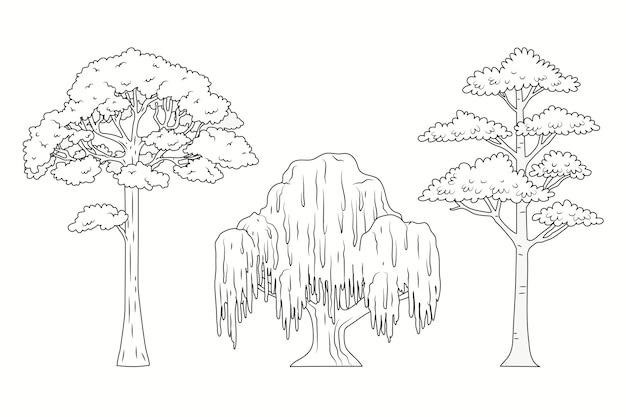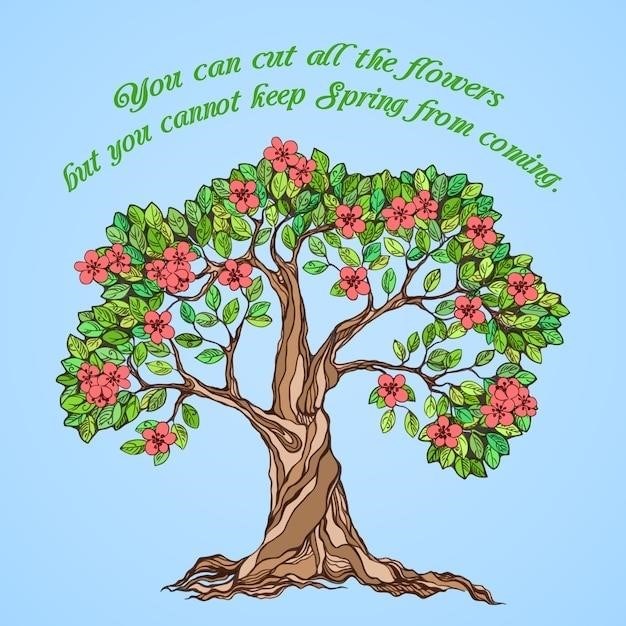The Great Kapok Tree⁚ A Synopsis
A man begins to chop down a massive kapok tree in the Amazon rainforest. He rests, falls asleep, and is awakened by the rainforest’s creatures pleading for their home’s preservation. The man ultimately changes his mind, leaving the tree unharmed.
The Story’s Opening⁚ The Man and the Tree
The narrative commences with a lone man, armed with an axe, in the heart of the Amazon rainforest. His intention is clear⁚ to fell a magnificent kapok tree, a colossal giant of the rainforest ecosystem. The sheer size of the tree is emphasized, highlighting its dominance and the significant impact its removal would have on the surrounding environment. The opening scene immediately establishes a conflict—the man’s intention versus the tree’s inherent value and the life it sustains. The description of the man’s actions, the swing of the axe, the sounds of the wood splitting, paints a vivid picture of deforestation and the destructive power of human intervention in nature. This initial scene sets the stage for the subsequent events and the crucial moral questions the story explores.
The Animals’ Plea⁚ A Chorus of Voices
As the man rests beneath the kapok tree, the story shifts to reveal the vibrant ecosystem it supports. A diverse array of animals, each integral to the rainforest’s delicate balance, emerge from the tree’s canopy and its roots. A boa constrictor, monkeys, sloths, and numerous other creatures, each with its own unique voice, approach the sleeping man. Their pleas aren’t aggressive, but rather a gentle chorus of warnings and explanations. They illustrate how the kapok tree provides shelter, food, and a vital habitat for countless species. The animals’ perspectives highlight the interconnectedness of the rainforest’s inhabitants and expose the far-reaching consequences of the man’s actions. Their collective voice underscores the moral responsibility of humans toward the environment and the fragility of the natural world.
The Man’s Transformation⁚ A Change of Heart
The cumulative effect of the animals’ pleas and the man’s prolonged exposure to the rainforest’s beauty profoundly impact his perspective. Initially driven by a single-minded purpose, he begins to understand the interconnectedness of the rainforest and the devastating consequences of his actions. The animals’ gentle yet persistent appeals awaken his conscience. He starts to recognize the kapok tree not merely as timber, but as a living entity crucial to the survival of countless creatures. This shift in perception isn’t instantaneous; it’s a gradual process fueled by the animals’ voices and the inherent majesty of the rainforest. Ultimately, the man’s transformation represents a profound shift from self-interest to environmental awareness, demonstrating the power of empathy and the potential for human change.

Ecological Significance of the Kapok Tree
The kapok tree, a keystone species, supports immense biodiversity in the Amazon rainforest. Its vast root system prevents erosion, and its canopy provides habitat for countless organisms.
Biodiversity Hotspot⁚ A Haven for Life
The Great Kapok Tree serves as a vibrant hub of biodiversity, teeming with a remarkable array of life. Its towering stature and expansive canopy create a microcosm of the rainforest ecosystem, providing shelter, food, and breeding grounds for numerous species. From the vibrant plumage of exotic birds nesting amongst its branches to the stealthy movements of arboreal mammals navigating its intricate network of roots and limbs, the tree’s presence is integral to the rainforest’s rich tapestry of life. Insects, amphibians, reptiles, and a multitude of other creatures find sustenance and refuge within its protective embrace. The interconnectedness of life within and around the kapok tree highlights the vital role it plays in maintaining the delicate balance of the rainforest ecosystem. Its presence is not merely a singular element but a cornerstone of the rainforest’s remarkable biological diversity. The sheer abundance of life it sustains underscores its importance as a critical component of the Amazonian ecosystem, a testament to the intricate web of life that thrives in this remarkable environment. The kapok tree stands as a symbol of the interconnectedness of life within the rainforest, a haven for countless species and a testament to the richness of biodiversity found in these vital ecosystems.
The Kapok Tree’s Role in the Rainforest Ecosystem
The majestic kapok tree plays a crucial role within the complex rainforest ecosystem. Its extensive root system helps stabilize the soil, preventing erosion and landslides, contributing to the overall stability of the environment. The tree’s massive canopy provides shade for the forest floor, regulating temperature and humidity, and creating a favorable microclimate for other plants and animals. Its flowers attract pollinators, playing a crucial part in the reproduction of various rainforest plants. The kapok tree’s fruit produces seeds dispersed by the wind, contributing to the regeneration and expansion of the forest. Furthermore, the tree serves as a habitat for a wide range of species, from insects and birds to monkeys and sloths, providing food and shelter, supporting the rich biodiversity of the rainforest. Its presence is essential for maintaining the delicate balance of the ecosystem, influencing nutrient cycling and water retention, and supporting the intricate web of life within the rainforest. The kapok tree’s ecological significance is undeniable, highlighting its importance in the overall health and functioning of the Amazon rainforest.
The Book’s Themes and Messages
The Great Kapok Tree powerfully conveys the interconnectedness of life and the urgent need for environmental conservation, advocating for responsible stewardship of our planet’s resources.
Environmental Conservation⁚ A Call to Action
The Great Kapok Tree serves as a potent allegory for the devastating consequences of deforestation and the urgent need for environmental conservation. The narrative vividly portrays the interconnectedness of the rainforest ecosystem, highlighting how the destruction of a single tree impacts countless lives. By showcasing the diverse array of animals that rely on the kapok tree for survival, the story emphasizes the far-reaching effects of human actions on the natural world. The man’s eventual change of heart underscores the importance of individual responsibility in protecting the environment. The book doesn’t shy away from depicting the harsh realities of habitat loss but ultimately offers a message of hope, suggesting that even small acts of conservation can make a significant difference. The readily available PDF versions of the book ensure its accessibility and allow for widespread dissemination of this crucial environmental message, fostering a greater understanding and appreciation for the delicate balance of nature.
Interdependence of Life⁚ A Web of Connections
The Great Kapok Tree masterfully illustrates the intricate web of life within a rainforest ecosystem. The story emphasizes how every creature, from the smallest insect to the largest mammal, plays a vital role in maintaining the delicate balance of nature. The kapok tree itself serves as a central hub, providing shelter and sustenance for a diverse community of animals. The book showcases the symbiotic relationships between different species, demonstrating how their survival is intrinsically linked. The animals’ pleas to the man highlight the interconnectedness of their fates, emphasizing that harming one part of the ecosystem inevitably affects the whole. This powerful message underscores the importance of respecting and preserving biodiversity, highlighting the consequences of disrupting the natural order. The narrative’s impact is amplified by the accessibility of the book in various formats, including readily available PDFs, making this crucial ecological lesson accessible to a wider audience.

Accessibility and Availability of the Book
Digital access is readily available through online PDFs and ebooks. Physical copies can be found in many libraries and bookstores worldwide, ensuring broad reach.
Online Versions⁚ PDFs and Ebooks
The digital age offers convenient access to “The Great Kapok Tree” through various online platforms. Numerous websites provide PDF downloads, allowing readers to obtain a copy instantly and read it on their computers, tablets, or e-readers. The ease of downloading and sharing PDFs has made the book widely available, bypassing geographical limitations and making it accessible to a global audience. Furthermore, the book is often available as an ebook, compatible with popular e-reading apps like Kindle, Nook, and others. This digital format offers features such as adjustable font sizes, bookmarks, and highlighting, enhancing the reading experience for users. These online versions contribute to the book’s continued popularity and widespread accessibility, catering to a diverse readership accustomed to digital formats. The availability of both PDF and ebook formats ensures that “The Great Kapok Tree” remains easily accessible to a wide audience, regardless of their preferred reading method or technological capabilities. This broad reach underscores the book’s enduring appeal and its ability to connect with readers across generations and geographical boundaries.
Physical Copies⁚ Libraries and Bookstores
For those who prefer the tactile experience of a physical book, “The Great Kapok Tree” remains readily available in various locations. Public libraries, both large and small, often stock children’s literature, and this beloved environmental story is likely to be found among their collections. Patrons can borrow the book for free, promoting accessibility to all. Many independent bookstores and larger chains also carry the book, often featuring it in their children’s sections or environmental literature displays. Purchasing a physical copy allows readers to add it to their personal collections, making it a cherished item that can be reread and shared with others. The continued presence of “The Great Kapok Tree” in libraries and bookstores ensures its physical accessibility, allowing readers to appreciate the illustrations and the feel of the book in their hands. This tangible connection further enriches the reading experience, complementing the digital accessibility offered by online platforms. The book’s presence in both physical and digital spaces underlines its enduring popularity and its lasting impact on readers of all ages;


